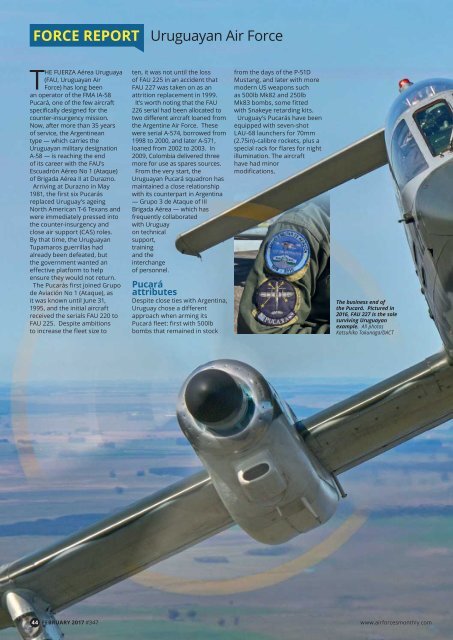Airforces Monthly - February 2017
Create successful ePaper yourself
Turn your PDF publications into a flip-book with our unique Google optimized e-Paper software.
FORCE REPORT Uruguayan Air Force<br />
THE FUERZA Aérea Uruguaya<br />
(FAU, Uruguayan Air<br />
Force) has long been<br />
an operator of the FMA IA-58<br />
Pucará, one of the few aircraft<br />
specifically designed for the<br />
counter-insurgency mission.<br />
Now, after more than 35 years<br />
of service, the Argentinean<br />
type — which carries the<br />
Uruguayan military designation<br />
A-58 — is reaching the end<br />
of its career with the FAU’s<br />
Escuadrón Aéreo No 1 (Ataque)<br />
of Brigada Aérea II at Durazno.<br />
Arriving at Durazno in May<br />
1981, the first six Pucarás<br />
replaced Uruguay’s ageing<br />
North American T-6 Texans and<br />
were immediately pressed into<br />
the counter-insurgency and<br />
close air support (CAS) roles.<br />
By that time, the Uruguayan<br />
Tupamaros guerrillas had<br />
already been defeated, but<br />
the government wanted an<br />
effective platform to help<br />
ensure they would not return.<br />
The Pucarás first joined Grupo<br />
de Aviación No 1 (Ataque), as<br />
it was known until June 31,<br />
1995, and the initial aircraft<br />
received the serials FAU 220 to<br />
FAU 225. Despite ambitions<br />
to increase the fleet size to<br />
ten, it was not until the loss<br />
of FAU 225 in an accident that<br />
FAU 227 was taken on as an<br />
attrition replacement in 1999.<br />
It’s worth noting that the FAU<br />
226 serial had been allocated to<br />
two different aircraft loaned from<br />
the Argentine Air Force. These<br />
were serial A-574, borrowed from<br />
1998 to 2000, and later A-571,<br />
loaned from 2002 to 2003. In<br />
2009, Colombia delivered three<br />
more for use as spares sources.<br />
From the very start, the<br />
Uruguayan Pucará squadron has<br />
maintained a close relationship<br />
with its counterpart in Argentina<br />
— Grupo 3 de Ataque of III<br />
Brigada Aérea — which has<br />
frequently collaborated<br />
with Uruguay<br />
on technical<br />
support,<br />
training<br />
and the<br />
interchange<br />
of personnel.<br />
Pucará<br />
attributes<br />
Despite close ties with Argentina,<br />
Uruguay chose a different<br />
approach when arming its<br />
Pucará fleet: first with 500lb<br />
bombs that remained in stock<br />
from the days of the P-51D<br />
Mustang, and later with more<br />
modern US weapons such<br />
as 500lb Mk82 and 250lb<br />
Mk83 bombs, some fitted<br />
with Snakeye retarding kits.<br />
Uruguay’s Pucarás have been<br />
equipped with seven-shot<br />
LAU-68 launchers for 70mm<br />
(2.75in)-calibre rockets, plus a<br />
special rack for flares for night<br />
illumination. The aircraft<br />
have had minor<br />
modifications,<br />
The business end of<br />
the Pucará. Pictured in<br />
2016, FAU 227 is the sole<br />
surviving Uruguayan<br />
example. All photos<br />
Katsuhiko Tokunaga/DACT<br />
44 FEBRUARY <strong>2017</strong> #347 www.airforcesmonthly.com


